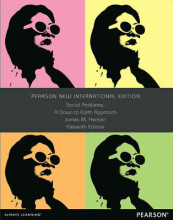Summary: Risk Behaviour And Addiction
- This + 400k other summaries
- A unique study and practice tool
- Never study anything twice again
- Get the grades you hope for
- 100% sure, 100% understanding
Read the summary and the most important questions on Risk behaviour and addiction
-
1 Lecture 1
This is a preview. There are 11 more flashcards available for chapter 1
Show more cards here -
What we tend to regard as 'risk behaviours' depends on:
Characteristics of the particalar substance or behaviour. E.g. Smoking vs gaming. For smoking integrated phase is already seen as addictive, but not for smoking
Cultural and societal norms. E.g. alcohol use in western vs. Islamic cultures
Scientific knowledge: knowledge on the risks of alcohol use for the cognitive development of adolescents -
Predictors of risk behaviour
3 things influence behaviour.
Capability, motivation and opportunity influence behaviour -
What are psychoactive substances
Chemical substances that cross theblood-brain barrier . andaffect thefunction of thecentral nervous system therebyaltering perception , mood, orconsciousness
Othercharacteristics :
inducecraving after use (with ciggaretts)
evoke loss of control after they have been used (more difficult to control behaviour) -
Two learning principles underlying the development of addiction:
Positive reinforcement occurs when the rate of abehaviour increases because adesirable event (euphoria, relaxation) is resulting from thebehaviour
Negativereinforcement occurs when the rate of abehaviour increases because an aversive event is prevented from happening (prevention ofwithdrawal symptoms) -
Why do we experience withdrawal symptoms
Drug use > dopamine release > reward >>>> brain adaption (the sensitivity of the reward system is decreasing) -
The decrease in sensitivity of the brain reward system
Reduction number of dopamine receptors
Making the existing receptors less sensitive to dopamine
Results:
Tolerance (needing more for same effect)
Withdrawal symptoms (during abstinence)
A reduced sensitivity to natural incentives (food, sex) -
Motivation is explicit and implicit
Explicit :self-reported (makkelijk te benoemen wat het is) and cravingImplicit : *onbewust en moeilijk te benomen*
- Cuereactivity (when users are shown a picture of weed, the brain reacts)- Incentive salience - Cognitive biases (interaction betweenmotivation & control)Incentive salience theory &associative learning Repeated use of drugs withrewarding outcomeDrug cues get paired with thisrewarding outcomeDrug cues itself become salient because ofpsysical and mental paring with reward
Cognitive biases: implicit and automatic cognitive processing of addiction related cues is altered
* Attentional bias
* Approach bias -
Implicit and explicit in cannabis use
Craving does increase cannabis use, attentional bias doesn't -
1.1 Sussman, A general introduction to the concept of addiction and addictive effects
This is a preview. There are 4 more flashcards available for chapter 1.1
Show more cards here -
Explain substance and behavioral addiction
Substance: repetitive intake of a drug (alcohol)
Behavioral: engaging in types of behaviour repetitively which are not directly taken into the body (gambling) -
Explain intensional and extensional conceptions of addiction
Intensional : definitions aims to describe a causal addiction process
Extensional: classifying characteristics of a drug (DSM5)
- Higher grades + faster learning
- Never study anything twice
- 100% sure, 100% understanding






























